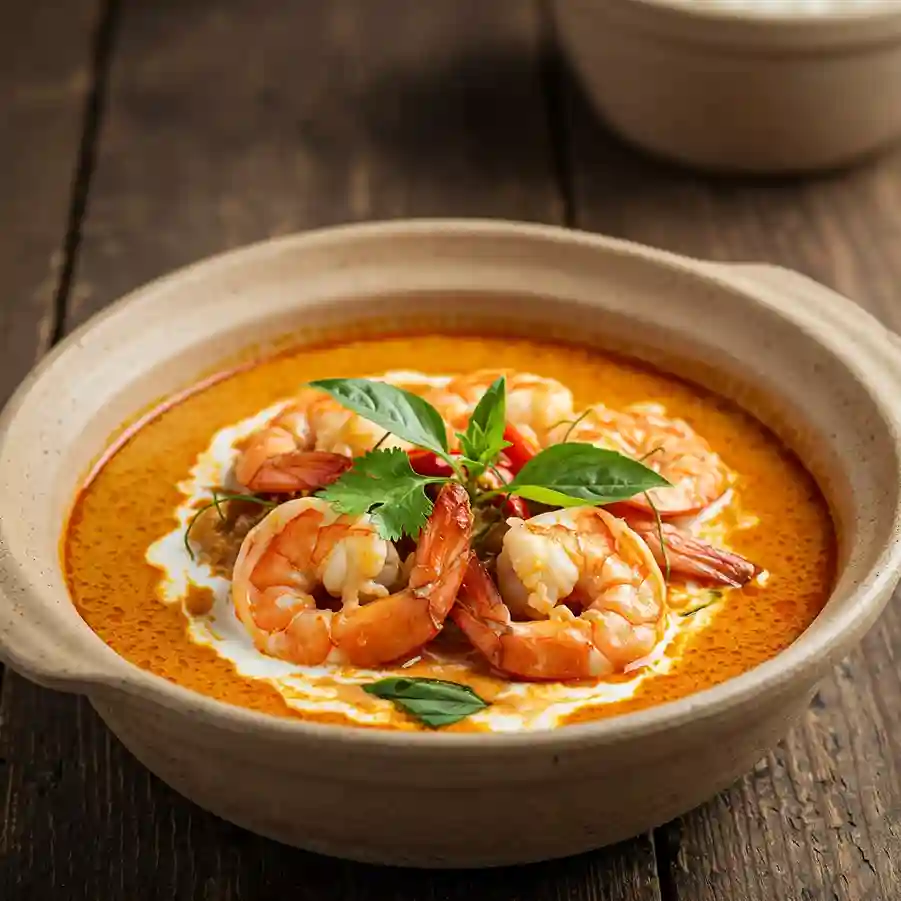I still remember the first time I had Thai red curry shrimp at a small roadside spot in Bangkok.
It was raining lightly, I was tired from walking all day, and the steam rising from that bowl was the most inviting thing in the world.
One spoonful, and I was hooked. The way the creamy coconut milk clung to the shrimp, how the heat slowly crept in from the red chilies, and the fragrance of lime leaves and Thai basil—nothing felt heavy, yet every bite was full of flavor.
This dish isn’t about showing off. It’s about balance. The richness of coconut milk, the sharpness of lime, the depth of the curry paste, and the punch of fresh herbs all work together like a group of friends who know exactly when to speak and when to stay quiet. That’s what makes it special.
What I love most about this version is how close it comes to what I tasted in Thailand—without needing anything fancy. You don’t need a suitcase full of rare ingredients or a chef’s degree.
Just a few honest, fresh things and some patience while it all simmers. If you’ve never cooked Thai food before, this is a great place to start—because once you taste that first spoonful, you’ll know it was worth every minute.
Table of Contents
ToggleAuthentic Thai Red Curry Shrimp Recipe
Ingredients
For The Curry Paste Base
- 2 tbsp Thai red curry paste (Mae Ploy or Aroy-D brands work great)
- 2 cloves garlic, minced
- 1 small shallot, finely chopped
- 1 tbsp grated galangal (or ginger if not available)
- 1 stalk lemongrass (white part only), finely chopped
- 1 tbsp oil (neutral, like canola or sunflower)
For The Curry
- 400ml coconut milk (full-fat, unsweetened)
- 250g large shrimp, peeled and deveined (leave tails on for presentation)
- 1 cup water or shrimp stock (homemade: simmer shrimp shells in water with garlic & lemongrass for 10 mins)
- 3 kaffir lime leaves, torn
- 2 Thai red chilies, halved (optional for heat)
- 1 tbsp palm sugar (or light brown sugar)
- 2 tbsp fish sauce
- 1 tbsp lime juice
- A small handful of Thai basil leaves (plus extra for garnish)
- 1 tsp finely chopped coriander stems
- 1–2 tbsp coconut cream (for drizzling at the end)
Garnish
- Thai basil and coriander sprigs
- Thin drizzle of coconut cream
- Optional: sliced red chili for color pop
Instructions
- Heat the oil in a heavy-bottomed pan or clay pot over medium-low heat. Add garlic, shallots, lemongrass, galangal, and curry paste. Sauté for 2–3 minutes until fragrant and the oil begins to separate from the paste.
- Pour in ¾ of the coconut milk (reserve the rest for garnish) and stir continuously to incorporate the paste fully into the milk. Let it simmer gently for 5 minutes until thickened slightly and reddish oil starts to rise.
- Add kaffir lime leaves, sugar, fish sauce, and chilies. Stir well and let it bubble for another 2 minutes to balance the flavor.
- Add the shrimp and water/shrimp stock. Simmer on medium heat just until the shrimp turn opaque and curl — about 3–4 minutes. Don’t overcook.
- Add the remaining coconut milk, Thai basil, and coriander stems. Stir once gently and turn off the heat.
- Taste and adjust — a pinch more sugar for balance, fish sauce for salt, or a squeeze more lime juice if needed.
- Ladle into a shallow serving bowl.
- Drizzle coconut cream in a swirl for that creamy, glossy finish. Garnish with basil sprigs, coriander, and fresh chili if using.

Success Tips For Perfect Thai Red Curry Shrimp
Here’s how to make sure your curry turns out rich, flavorful, and not overcooked:
- Use full-fat coconut milk: It gives the curry that creamy, thick texture and deep flavor. Don’t use light versions or coconut beverages.
- Don’t skip aromatics: Ingredients like lemongrass, kaffir lime leaves, galangal, garlic, and shallots bring real Thai flavor. Fresh is best, but frozen works too.
- Cook curry paste in oil first: This step wakes up the spices and makes the curry taste richer and more balanced.
- Add shrimp last: Shrimp cook quickly, so add them toward the end and pull them off the heat as soon as they turn pink and curl.
- Taste and balance: Thai food is all about balance. If it’s too salty, add a little sugar or lime juice. If it’s too sweet, add more fish sauce or a squeeze of lime.
- Don’t overboil: Once the curry is simmering, keep it on low heat. High heat can split the coconut milk or make the shrimp tough.
Substitutions And Variations
You can still enjoy Thai red curry shrimp if you need to swap ingredients or want to switch things up:
- Use chicken instead of shrimp: Boneless thighs or breast, thinly sliced, cook beautifully in red curry.
- Try tofu or mushrooms: Firm tofu or meaty mushrooms like oyster or shiitake are great for a plant-based version.
- Replace fish sauce with soy sauce: If you’re avoiding fish-based ingredients, light soy sauce adds a salty depth.
- Use homemade shrimp stock or vegetable stock: Either will bring richness to the broth.
- Add veggies: Bamboo shoots, baby corn, red bell peppers, snap peas, or zucchini are all great options to bulk up the dish.
- Spice control: Reduce or skip Thai chilies if you prefer a milder curry. Add them at the end if you want extra heat.
Why Is My Shrimp Rubbery And Tough?
If your shrimp feel chewy or rubbery, they’re likely overcooked. Here’s how to avoid that:
- Don’t walk away while cooking: Shrimp cook fast — usually in just 2–4 minutes. Keep an eye on them.
- Watch the shape: When shrimp form a tight “O” shape, they’re probably overdone. A loose “C” shape means they’re just right.
- Cook in simmer, not boil: High heat makes them tough. Simmer the curry gently once the shrimp go in.
- Use large or jumbo shrimp: Smaller shrimp cook quicker and are easier to overcook.
What To Serve With Thai Red Curry Shrimp?
Serve it with dishes that soak up the curry or complement the bold Thai flavors:
- Steamed jasmine rice
- Sticky rice
- Thai fried rice
- Roti or paratha
- Stir-fried morning glory (pak boong)
- Thai-style cucumber salad
- Thai eggplant stir-fry
- Glass noodles with garlic oil
How To Store And Reheat Thai Red Curry Shrimp?
Here’s how to keep leftovers tasty and safe to eat:
- Cool completely before storing: Let the curry come to room temperature, then place in an airtight container.
- Refrigerate for up to 3 days: Keep in the fridge and make sure it’s sealed tight to hold in flavor.
- Reheat gently: Warm it in a saucepan over low heat. Stir often and avoid boiling, especially if it contains shrimp or coconut milk.
- Microwave method: Heat in short bursts, stirring in between to make sure it heats evenly. Use a lid to avoid splashes.
- Don’t freeze with shrimp: Shrimp can get rubbery once thawed. If you plan to freeze, make the curry base without shrimp, then add fresh shrimp when reheating.

You May Also Like To Check Out These Recipes
- Oven Baked Sweet Potato Chips
- Viral Tiktok Cucumber Salad
- Funeral Potatoes With Hashbrowns
- Chinese Special Fried Rice Restaurant Style
- Authentic Spanish Seafood Paella
- Homemade Pretzel Crust Pizza
- Tomato Pasta
- Cheese Danish
- Baked Chicken Nuggets
- Spring Rolls
- Chicken Egg Rolls
- Creamy Cherry Tomato Pasta
- 5 Ingredient Orange Chicken
- Egg Roll In A Bowl
- Chicken Biryani
- Creamy Mushroom Pasta
- Cucumber Sandwiches
- Chicken Korma
- Grilled Fish Tacos With Cabbage Slaw
- Best Indian Mango Chicken Curry












1 thought on “Authentic Thai Red Curry Shrimp”
Very easy to make and delicious…. I didn’t find it very spicy so added some siracha…